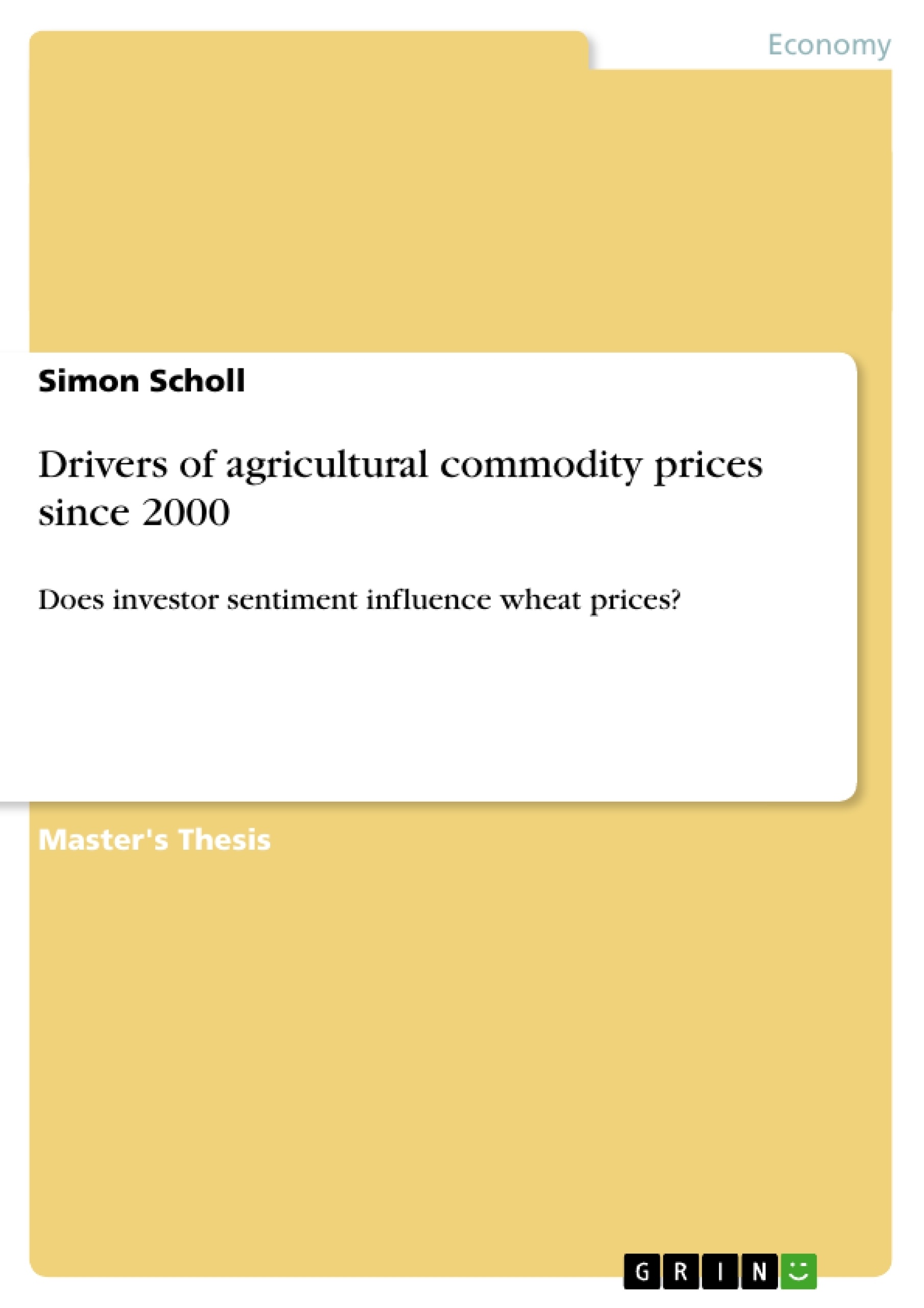Since the prices in the agricultural commodity market surged in 2008 and 2011 many articles investigated these turbulences from different perspectives.
However, neither fundamental factors nor increased financial speculation provides a completely satisfactory explanation on this complex topic. Our study therefore tries to capture all these factors in a single approach and investigates the impact of investor sentiment on wheat futures returns. We construct an investor sentiment index out of monthly data from the period 2000 to 2013 by conducting a principal component analysis (PCA) with a set of well-established sentiment proxies. In particular, we employ three equity market proxies suggested by Baker & Wurgler (2007) and three wheat market specific sentiment proxies, in order to obtain a tailored investor sentiment index.
The sentiment index is statistical significant at the 95 per cent significance level and predicts about 2.45 per cent of the total variation in the subsequent month wheat futures returns. The results are also robust after controlling for fundamental factors in an extended multiple linear regression analysis. Our sentiment index therefore proves that investor sentiment impacts wheat futures returns, although further research is needed to verify this relationship.
Inhaltsverzeichnis (Table of Contents)
- INTRODUCTION
- LITERATURE REVIEW
- Fundamental and political factors influencing food prices.
- Demand from developing countries
- Increasing oil price
- Expanded biofuel production
- Low stocks in agricultural commodities.
- Adverse meteorological conditions.
- Food policies.
- Other fundamental factors
- Financialization in the agricultural commodity market.
- Increasing financial speculation has no impact on agricultural commodity markets
- Increasing financial speculation is beneficial.
- Financial speculation is harmful to agricultural commodity markets
- Evidences for the impact of investor's sentiment on asset prices
- ANALYSIS OF POTENTIAL SENTIMENT PROXIES
- AAll Investor Sentiment Survey
- AAll data and limitations
- Implied volatility of S&P500 index options.
- First-day returns on initial public offerings.
- First-day IPO returns data and limitations.
- Closed-end fund discount.
- Closed-end fund discount data and limitation
- Open interest in the wheat futures market.
- Open interest data and limitations.
- Trading volume in the wheat futures market
- Trading volume data and limitation..
- Wheat futures returns.
- Limitations of wheat futures returns..
- EMPIRICAL EVIDENCE
- Descriptive Statistics of relevant variables.
- Construction of the composite sentiment index
- Preliminary sentiment index
- Controlling for macroeconomic influences..
- Controlling for the capital market..
- Comparison to other sentiment indices
- Does the sentiment index capture mood swings in the wheat market?
- Interdependence between investor sentiment and returns on wheat futures..
- Interdependence between SENT 1# and returns on wheat futures
- Dependence between investor sentiment and returns on wheat futures .........
- Simple linear time series regression analysis.......
- Multiple linear time series regression analysis.
- The role of fundamental factors in agricultural commodity price dynamics.
- The influence of financialization and speculation on commodity markets.
- The impact of investor sentiment on wheat futures returns.
- The construction and validation of a sentiment index specific to the wheat market.
- The relationship between investor sentiment and wheat futures returns.
- Chapter 1: Introduction provides an overview of the dissertation’s scope and research objectives, highlighting the importance of understanding the factors influencing agricultural commodity prices, particularly wheat. It explores the literature review, outlining the existing knowledge about fundamental factors, financialization, and sentiment.
- Chapter 2: Analysis of Potential Sentiment Proxies delves into the selection and analysis of potential sentiment proxies to construct a composite sentiment index. It examines various data sources, including surveys, market indicators, and trading activity, evaluating their relevance and limitations in capturing investor sentiment.
- Chapter 3: Empirical Evidence presents the empirical results of the study, including the construction of the composite sentiment index using principal component analysis (PCA) and the analysis of its impact on wheat futures returns through regression models. It also explores the robustness of the findings after controlling for other relevant factors.
Zielsetzung und Themenschwerpunkte (Objectives and Key Themes)
This dissertation examines the impact of investor sentiment on wheat futures returns, addressing the complexities of agricultural commodity price fluctuations since 2000. It aims to develop a comprehensive understanding of the interplay between fundamental factors, financial speculation, and investor sentiment in shaping wheat prices.Zusammenfassung der Kapitel (Chapter Summaries)
Schlüsselwörter (Keywords)
The study focuses on agricultural commodity prices, investor sentiment, wheat futures returns, financial speculation, and the development and application of a sentiment index. It delves into the complexities of agricultural markets, exploring the interplay of fundamental factors, financialization, and investor sentiment.- Arbeit zitieren
- Simon Scholl (Autor:in), 2013, Drivers of agricultural commodity prices since 2000, München, GRIN Verlag, https://www.grin.com/document/264600



